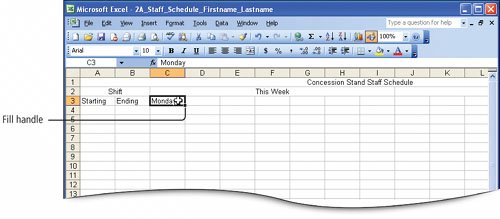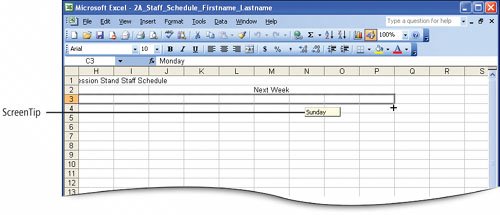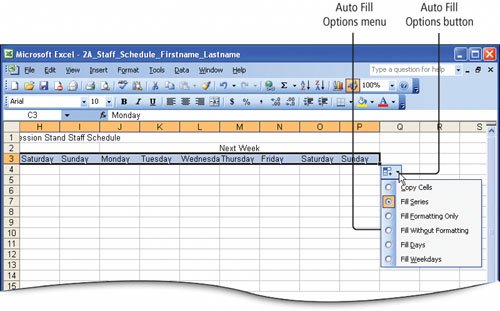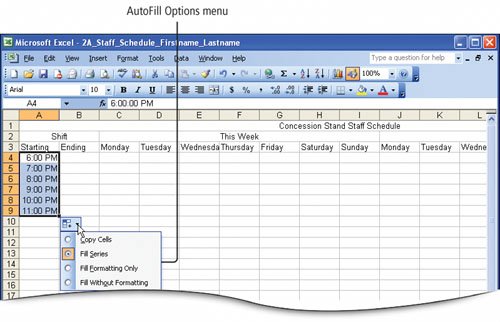Objective 1. Use AutoFill to Fill a Pattern of Column and Row Titles
Excel's AutoFill feature can generate a series of values into adjacent cells, based on the value of other cells. A series is a group of things that come one after another in succession. For example, January, February, March, April, and so on, is a series. The days of the week form a series. Quarter 1, Quarter 2, Quarter 3, and Quarter 4 form a series. The numbers 1, 2, 3, 4, 5 and 10, 15, 20, 25 are series. Excel's AutoFill feature completes a series so that you do not have to type every value.
Activity 2.1. Using AutoFill to Extend a Pattern of Days
Usually you begin a new worksheet by typing titles to identify the data that you plan to place in the rows and columns. When a series of values comprises your column or row titles, for example January, February, and March, you can enter the first value and then use the AutoFill feature to fill in the remaining titles.
|
1. |
Start Excel and Close |
|
2. |
In cell A1, type Concession Stand Staff Schedule as the title of the worksheet, and then press Alert!: Selecting Beyond the Edge of the Screen May Cause Rapid Scrolling Selecting a range of cells that extends beyond the edge of the screen may cause rapid scrolling. This rapid scrolling might cause the selection to extend beyond your intended location. Continue holding down the mouse button and moving up or down or left or right until you have the selection you want. Or, type the range into the Name Box instead of selecting with the mouse. |
|
3. |
In cell A2, type Shift and then press |
|
4. |
Scroll to view columns J through P on your screen. In cell J2, type Next Week and then press |
|
|
|
|
5. |
Press |
|
6. |
Click cell C3 to make it the active cell, and then notice the small black square in the lower right corner of the cell as shown in Figure 2.2. Figure 2.2. 
You can drag the fill handlethe small black square in the lower right corner of a selected cellto adjacent cells to fill the cells with values based on the first cell in the series. |
|
7. |
Point to the fill handle until your mouse pointer changes from the Figure 2.3. (This item is displayed on page 698 in the print version) 
After you release the mouse button, the days Monday through Sunday are filled in, and then repeat in the second week. A button displays at the end of the series. Another Way: To Fill a Range of Cells You can type the range into the Name Box, and then from the menu click Edit, point to Fill, and then click Series. In the Series dialog box, under Type, click AutoFill and then click OK. |
|
8. |
Point to the Auto Fill Options button Figure 2.4. (This item is displayed on page 699 in the print version) 
The Auto Fill Options button is a type of smart tag. When Excel recognizes certain types of data, Excel labels the data with a smart tag. Some smart tags, for example, the Auto Fill Options button, provide a menu of options related to the current task. Because the options are related to the current task, the tag or button is referred to as being context-sensitive. The menu lists commands that offer ways to fill the selected cells. On the displayed menu, Fill Series is selected, indicating the action that was taken. From the displayed menu, you could also select other actions. For example, if you click Fill Weekdays, the days Monday through Friday will fill the range without Saturday or Sunday. As you progress in your study of Excel, you will encounter additional smart tags that provide context-sensitive commands. |
|
|
|
|
9. |
Click any empty cell to close the Auto Fill Options menu without changing the selection. On the Standard toolbar, click the Save button |
More Knowledge: Smart Tags
Smart tags were first introduced in Microsoft Office XP. In Microsoft Office 2003, smart tags have been made even smarter. Using various types of software, organizations can develop their own custom smart tags, and smart tags can automatically search for information on the Web.
Activity 2.2. Using AutoFill to Extend a Pattern of Times
A series of dates or times can form row or column titles. If you place a time in a cell using a colonsuch as 6:00or with AM or PM, Excel will identify it as a time of day and apply a time format. You can fill a date or time into adjacent cells and the formatting is also filled unless you select a different option from the smart tag. The evening shifts start at 6 PM. The final shift begins at 11 PM and ends at midnight. Instead of typing each time period, you can type one time period and then have AutoFill complete the series of row titles.
|
1. |
Hold down |
||||||||||||||||||||||||||
|
|
|||||||||||||||||||||||||||
|
2. |
Click cell A4 to make it the active cell, point to the fill handle until your mouse pointer changes to the |
||||||||||||||||||||||||||
|
3. |
Click the Auto Fill Options button arrow to display a menu, and then compare your screen with Figure 2.5. Figure 2.5. 
The menu offers commands regarding ways to fill the selected cells. On the displayed menu, Fill Series is selected, indicating the action that was taken. Notice that the smart tag is context sensitive and displays different commands for this time series, as compared to the options on the smart tag for the series of days. A smart tag remains on the screen until you take some other action or until you press  . . |
||||||||||||||||||||||||||
|
4. |
Click cell B4, type 7 PM and then press |
||||||||||||||||||||||||||
|
5. |
Save
|
More Knowledge: Specifying Fill Intervals
The AutoFill feature assumes an interval of time such as one hour for times or one day for dates. If you want a different interval, you can specify the interval by providing an example. To provide an example, type the first two times or dates in the first two cells of the series. Then select both cells and drag the fill handle. Alternatively, begin to drag the fill handle using the right mouse button, release the mouse button, and a shortcut menu will display. From the menu, click Series. Then, in the displayed dialog box, increase the Step value, which is the interval between values in the series. Use whole numbers for intervals of days and decimal fractions for intervals of hours. For example an interval of 6 hours would be a step value of .25a quarter of a day.
|
[Page 701 (continued)] Objective 2 Copy Text Using the Fill Handle |
Windows XP
- Chapter One. Getting Started with Windows XP
- Project 1A. Windows XP
- Objective 1. Get Started with Windows XP
- Objective 2. Resize, Move, and Scroll Windows
- Objective 3. Maximize, Restore, Minimize, and Close a Window
- Objective 4. Create a New Folder
- Objective 5. Copy, Move, Rename, and Delete Files
- Objective 6. Find Files and Folders
- Objective 7. Compress Files
- Summary
- Key Terms
- Concepts Assessments
Outlook 2003
- Chapter One. Getting Started with Outlook 2003
- Getting Started with Microsoft Office Outlook 2003
- Project 1A. Exploring Outlook 2003
- Objective 1. Start and Navigate Outlook
- Objective 2. Read and Respond to E-mail
- Objective 3. Store Contact and Task Information
- Objective 4. Work with the Calendar
- Objective 5. Delete Outlook Information and Close Outlook
- Summary
- Key Terms
- Concepts Assessments
- Skill Assessments
- Performance Assessments
- Mastery Assessments
- Problem Solving
- GO! with Help
Internet Explorer
- Chapter One. Getting Started with Internet Explorer
- Getting Started with Internet Explorer 6.0
- Project 1A. College and Career Information
- Objective 1. Start Internet Explorer and Identify Screen Elements
- Objective 2. Navigate the Internet
- Objective 3. Create and Manage Favorites
- Objective 4. Search the Internet
- Objective 5. Save and Print Web Pages
- Summary
- Key Terms
- Concepts Assessments
- Skill Assessments
- Performance Assessments
- Mastery Assessments
- Problem Solving
Computer Concepts
- Chapter One. Basic Computer Concepts
- Objective 1. Define Computer and Identify the Four Basic Computing Functions
- Objective 2. Identify the Different Types of Computers
- Objective 3. Describe Hardware Devices and Their Uses
- Objective 4. Identify Types of Software and Their Uses
- Objective 5. Describe Networks and Define Network Terms
- Objective 6. Identify Safe Computing Practices
- Summary
- In this Chapter You Learned How to
- Key Terms
- Concepts Assessments
Word 2003
Chapter One. Creating Documents with Microsoft Word 2003
- Chapter One. Creating Documents with Microsoft Word 2003
- Getting Started with Microsoft Office Word 2003
- Project 1A. Thank You Letter
- Objective 1. Create and Save a New Document
- Objective 2. Edit Text
- Objective 3. Select, Delete, and Format Text
- Objective 4. Create Footers and Print Documents
- Project 1B. Party Themes
- Objective 5. Navigate the Word Window
- Objective 6. Add a Graphic to a Document
- Objective 7. Use the Spelling and Grammar Checker
- Objective 8. Preview and Print Documents, Close a Document, and Close Word
- Objective 9. Use the Microsoft Help System
- Summary
- Key Terms
- Concepts Assessments
- Skill Assessments
- Performance Assessments
- Mastery Assessments
- Problem Solving
- You and GO!
- Business Running Case
- GO! with Help
Chapter Two. Formatting and Organizing Text
- Formatting and Organizing Text
- Project 2A. Alaska Trip
- Objective 1. Change Document and Paragraph Layout
- Objective 2. Change and Reorganize Text
- Objective 3. Create and Modify Lists
- Project 2B. Research Paper
- Objective 4. Insert and Format Headers and Footers
- Objective 5. Insert Frequently Used Text
- Objective 6. Insert and Format References
- Summary
- Key Terms
- Concepts Assessments
- Skill Assessments
- Performance Assessments
- Mastery Assessments
- Problem Solving
- You and GO!
- Business Running Case
- GO! with Help
Chapter Three. Using Graphics and Tables
- Using Graphics and Tables
- Project 3A. Job Opportunities
- Objective 1. Insert and Modify Clip Art and Pictures
- Objective 2. Use the Drawing Toolbar
- Project 3B. Park Changes
- Objective 3. Set Tab Stops
- Objective 4. Create a Table
- Objective 5. Format a Table
- Objective 6. Create a Table from Existing Text
- Summary
- Key Terms
- Concepts Assessments
- Skill Assessments
- Performance Assessments
- Mastery Assessments
- Problem Solving
- You and GO!
- Business Running Case
- GO! with Help
Chapter Four. Using Special Document Formats, Columns, and Mail Merge
- Using Special Document Formats, Columns, and Mail Merge
- Project 4A. Garden Newsletter
- Objective 1. Create a Decorative Title
- Objective 2. Create Multicolumn Documents
- Objective 3. Add Special Paragraph Formatting
- Objective 4. Use Special Character Formats
- Project 4B. Water Matters
- Objective 5. Insert Hyperlinks
- Objective 6. Preview and Save a Document as a Web Page
- Project 4C. Recreation Ideas
- Objective 7. Locate Supporting Information
- Objective 8. Find Objects with the Select Browse Object Button
- Project 4D. Mailing Labels
- Objective 9. Create Labels Using the Mail Merge Wizard
- Summary
- Key Terms
- Concepts Assessments
- Skill Assessments
- Performance Assessments
- Mastery Assessments
- Problem Solving
- You and GO!
- Business Running Case
- GO! with Help
Excel 2003
Chapter One. Creating a Worksheet and Charting Data
- Creating a Worksheet and Charting Data
- Project 1A. Tableware
- Objective 1. Start Excel and Navigate a Workbook
- Objective 2. Select Parts of a Worksheet
- Objective 3. Enter and Edit Data in a Worksheet
- Objective 4. Construct a Formula and Use the Sum Function
- Objective 5. Format Data and Cells
- Objective 6. Chart Data
- Objective 7. Annotate a Chart
- Objective 8. Prepare a Worksheet for Printing
- Objective 9. Use the Excel Help System
- Project 1B. Gas Usage
- Objective 10. Open and Save an Existing Workbook
- Objective 11. Navigate and Rename Worksheets
- Objective 12. Enter Dates and Clear Formats
- Objective 13. Use a Summary Sheet
- Objective 14. Format Worksheets in a Workbook
- Summary
- Key Terms
- Concepts Assessments
- Skill Assessments
- Performance Assessments
- Mastery Assessments
- Problem Solving
- You and GO!
- Business Running Case
- GO! with Help
Chapter Two. Designing Effective Worksheets
- Designing Effective Worksheets
- Project 2A. Staff Schedule
- Objective 1. Use AutoFill to Fill a Pattern of Column and Row Titles
- Objective 2. Copy Text Using the Fill Handle
- Objective 3. Use AutoFormat
- Objective 4. View, Scroll, and Print Large Worksheets
- Project 2B. Inventory Value
- Objective 5. Design a Worksheet
- Objective 6. Copy Formulas
- Objective 7. Format Percents, Move Formulas, and Wrap Text
- Objective 8. Make Comparisons Using a Pie Chart
- Objective 9. Print a Chart on a Separate Worksheet
- Project 2C. Population Growth
- Objective 10. Design a Worksheet for What-If Analysis
- Objective 11. Perform What-If Analysis
- Objective 12. Compare Data with a Line Chart
- Summary
- Key Terms
- Concepts Assessments
- Skill Assessments
- Performance Assessments
- Mastery Assessments
- Problem Solving
- You and GO!
- Business Running Case
- GO! with Help
Chapter Three. Using Functions and Data Tables
- Using Functions and Data Tables
- Project 3A. Geography Lecture
- Objective 1. Use SUM, AVERAGE, MIN, and MAX Functions
- Objective 2. Use a Chart to Make Comparisons
- Project 3B. Lab Supervisors
- Objective 3. Use COUNTIF and IF Functions, and Apply Conditional Formatting
- Objective 4. Use a Date Function
- Project 3C. Loan Payment
- Objective 5. Use Financial Functions
- Objective 6. Use Goal Seek
- Objective 7. Create a Data Table
- Summary
- Key Terms
- Concepts Assessments
- Skill Assessments
- Performance Assessments
- Mastery Assessments
- Problem Solving
- You and GO!
- Business Running Case
- GO! with Help
Access 2003
Chapter One. Getting Started with Access Databases and Tables
- Getting Started with Access Databases and Tables
- Project 1A. Academic Departments
- Objective 1. Rename a Database
- Objective 2. Start Access, Open an Existing Database, and View Database Objects
- Project 1B. Fundraising
- Objective 3. Create a New Database
- Objective 4. Create a New Table
- Objective 5. Add Records to a Table
- Objective 6. Modify the Table Design
- Objective 7. Create Table Relationships
- Objective 8. Find and Edit Records in a Table
- Objective 9. Print a Table
- Objective 10. Close and Save a Database
- Objective 11. Use the Access Help System
- Summary
- Key Terms
- Concepts Assessments
- Skill Assessments
- Performance Assessments
- Mastery Assessments
- Problem Solving Assessments
- Problem Solving
- You and GO!
- Business Running Case
- GO! with Help
Chapter Two. Sort, Filter, and Query a Database
- Sort, Filter, and Query a Database
- Project 2A. Club Fundraiser
- Objective 1. Sort Records
- Objective 2. Filter Records
- Objective 3. Create a Select Query
- Objective 4. Open and Edit an Existing Query
- Objective 5. Sort Data in a Query
- Objective 6. Specify Text Criteria in a Query
- Objective 7. Print a Query
- Objective 8. Specify Numeric Criteria in a Query
- Objective 9. Use Compound Criteria
- Objective 10. Create a Query Based on More Than One Table
- Objective 11. Use Wildcards in a Query
- Objective 12. Use Calculated Fields in a Query
- Objective 13. Group Data and Calculate Statistics in a Query
- Summary
- Key Terms
- Concepts Assessments
- Skill Assessments
- Performance Assessments
- Mastery Assessments
- Problem Solving
- You and GO!
- Business Running Case
- GO! with Access Help
Chapter Three. Forms and Reports
- Forms and Reports
- Project 3A. Fundraiser
- Objective 1. Create an AutoForm
- Objective 2. Use a Form to Add and Delete Records
- Objective 3. Create a Form Using the Form Wizard
- Objective 4. Modify a Form
- Objective 5. Create an AutoReport
- Objective 6. Create a Report Using the Report Wizard
- Objective 7. Modify the Design of a Report
- Objective 8. Print a Report and Keep Data Together
- Summary
- Key Terms
- Concepts Assessments
- Skill Assessments
- Performance Assessments
- Mastery Assessments
- Problem Solving
- You and GO!
- Business Running Case
- GO! with Help
Powerpoint 2003
Chapter One. Getting Started with PowerPoint 2003
- Getting Started with PowerPoint 2003
- Project 1A. Expansion
- Objective 1. Start and Exit PowerPoint
- Objective 2. Edit a Presentation Using the Outline/Slides Pane
- Objective 3. Format and Edit a Presentation Using the Slide Pane
- Objective 4. View and Edit a Presentation in Slide Sorter View
- Objective 5. View a Slide Show
- Objective 6. Create Headers and Footers
- Objective 7. Print a Presentation
- Objective 8. Use PowerPoint Help
- Summary
- Key Terms
- Concepts Assessments
- Skill Assessments
- Performance Assessments
- Mastery Assessments
- Problem Solving
- You and GO!
- Business Running Case
- GO! with Help
Chapter Two. Creating a Presentation
- Creating a Presentation
- Project 2A. Teenagers
- Objective 1. Create a Presentation
- Objective 2. Modify Slides
- Project 2B. History
- Objective 3. Create a Presentation Using a Design Template
- Objective 4. Import Text from Word
- Objective 5. Move and Copy Text
- Summary
- Key Terms
- Concepts Assessments
- Skill Assessments
- Performance Assessments
- Mastery Assessments
- Problem Solving
- You and GO!
- Business Running Case
- GO! with Help
Chapter Three. Formatting a Presentation
- Project 3A. Emergency
- Objective 1. Format Slide Text
- Objective 2. Modify Placeholders
- Objective 3. Modify Slide Master Elements
- Objective 4. Insert Clip Art
- Project 3B. Volunteers
- Objective 5. Apply Bullets and Numbering
- Objective 6. Customize a Color Scheme
- Objective 7. Modify the Slide Background
- Objective 8. Apply an Animation Scheme
- Summary
- Key Terms
- Concepts Assessments
- Skill Assessments
- Performance Assessments
- Mastery Assessments
- Problem Solving
- You and GO!
- Business Running Case
- GO! with Help
Integrated Projects
Chapter One. Using Access Data with Other Office Applications
- Chapter One. Using Access Data with Other Office Applications
- Introduction
- Project 1A. Meeting Slides
- Objective 1. Export Access Data to Excel
- Objective 2. Create a Formula in Excel
- Objective 3. Create a Chart in Excel
- Objective 4. Copy Access Data into a Word Document
- Objective 5. Copy Excel Data into a Word Document
- Objective 6. Insert an Excel Chart into a PowerPoint Presentation
Chapter Two. Using Tables in Word and Excel
- Chapter Two. Using Tables in Word and Excel
- Introduction
- Project 2A. Meeting Notes
- Objective 1. Plan a Table in Word
- Objective 2. Enter Data and Format a Table in Word
- Objective 3. Create a Table in Word from Excel Data
- Objective 4. Create Excel Worksheet Data from a Word Table
Chapter Three. Using Excel as a Data Source in a Mail Merge
- Chapter Three. Using Excel as a Data Source in a Mail Merge
- Introduction
- Project 3A. Mailing Labels
- Objective 1. Prepare a Mail Merge Document as Mailing Labels
- Objective 2. Choose an Excel Worksheet as a Data Source
- Objective 3. Produce and Save Merged Mailing Labels
- Objective 4. Open a Saved Main Document for Mail Merge
Chapter Four. Linking Data in Office Documents
- Chapter Four. Linking Data in Office Documents
- Introduction
- Project 4A. Weekly Sales
- Objective 1. Insert and Link in Word an Excel Object
- Objective 2. Format an Object in Word
- Objective 3. Open a Word Document That Includes a Linked Object, and Update Links
Chapter Five. Creating Presentation Content from Office Documents
EAN: 2147483647
Pages: 448
 the Getting Started task pane. From the File menu, click Save As. In the Save As dialog box, click the Save in arrow, navigate to the location where you are storing your projects, click the Create New Folder button
the Getting Started task pane. From the File menu, click Save As. In the Save As dialog box, click the Save in arrow, navigate to the location where you are storing your projects, click the Create New Folder button  , and then create a folder named Excel Chapter 2 Press
, and then create a folder named Excel Chapter 2 Press  to make your new folder the active folder. In the File name box, type 2A_Staff_Schedule_Firstname_Lastname and then click Save or press
to make your new folder the active folder. In the File name box, type 2A_Staff_Schedule_Firstname_Lastname and then click Save or press  .
. to move to cell A1. In cell A3, type Starting and then press
to move to cell A1. In cell A3, type Starting and then press  . In cell B3, type Ending and then press
. In cell B3, type Ending and then press  pointer to the
pointer to the  pointer, hold down the left mouse button, drag to the right through cell P3, and as you do so, notice that a ScreenTip displays for each day of the week, as shown in Figure 2.3. Release the left mouse button. If you are not satisfied with your result, click Undo and begin again.
pointer, hold down the left mouse button, drag to the right through cell P3, and as you do so, notice that a ScreenTip displays for each day of the week, as shown in Figure 2.3. Release the left mouse button. If you are not satisfied with your result, click Undo and begin again. to display its ScreenTip. Then, click the Auto Fill Options button arrow to display a menu. Compare your screen with Figure 2.4.
to display its ScreenTip. Then, click the Auto Fill Options button arrow to display a menu. Compare your screen with Figure 2.4. .
. and press
and press  to move to cell A1recall that this is a convenient way to move to the upper left portion of the worksheet. Click cell A4, type 6 PM and then press
to move to cell A1recall that this is a convenient way to move to the upper left portion of the worksheet. Click cell A4, type 6 PM and then press 